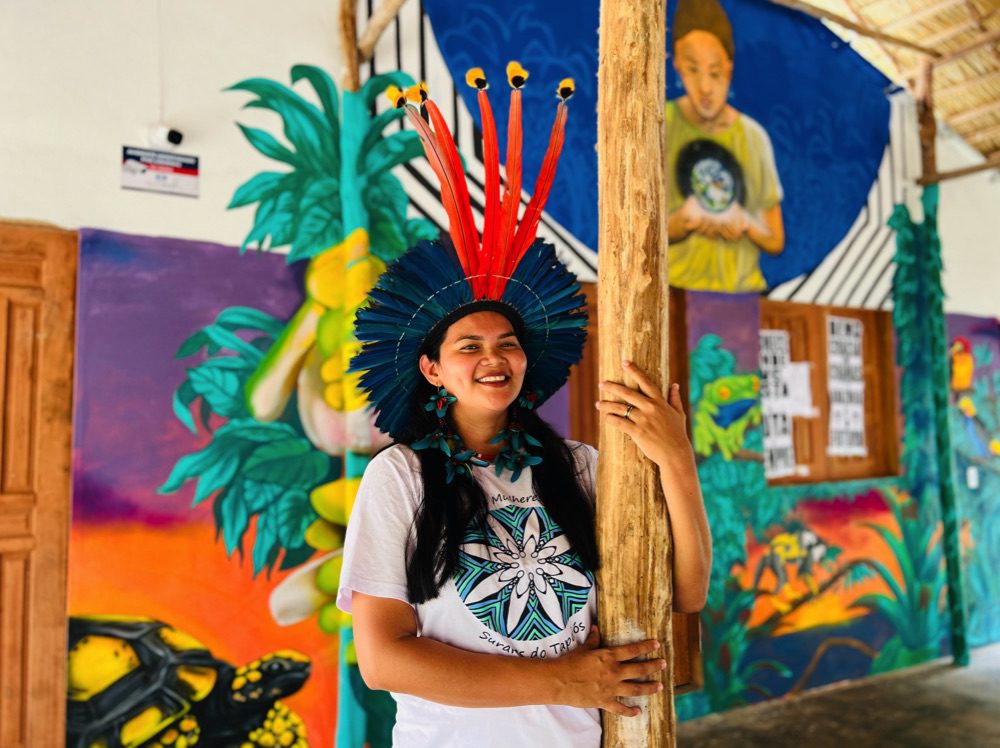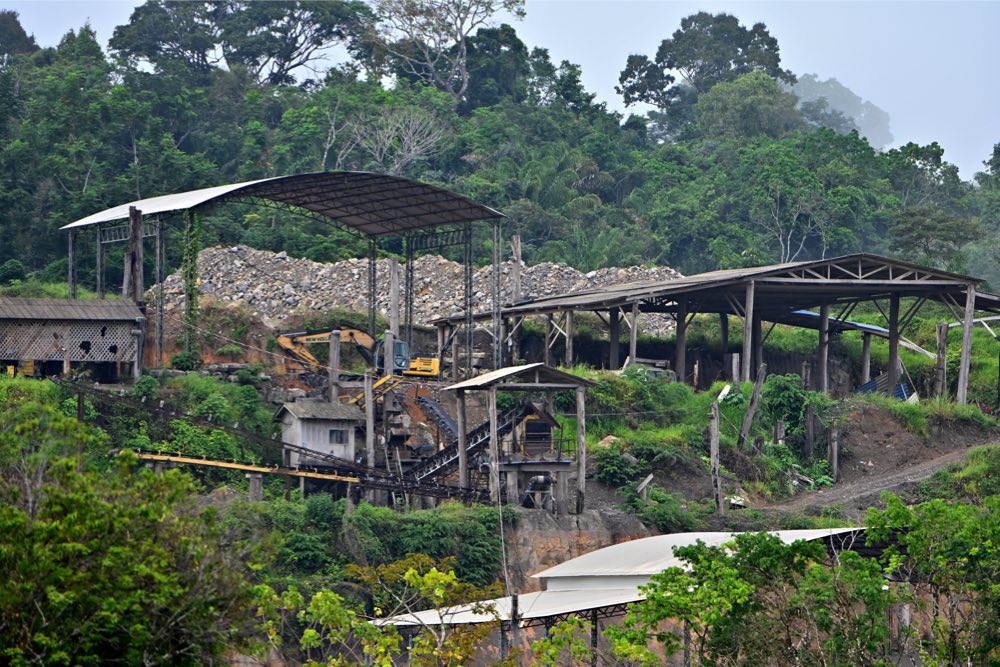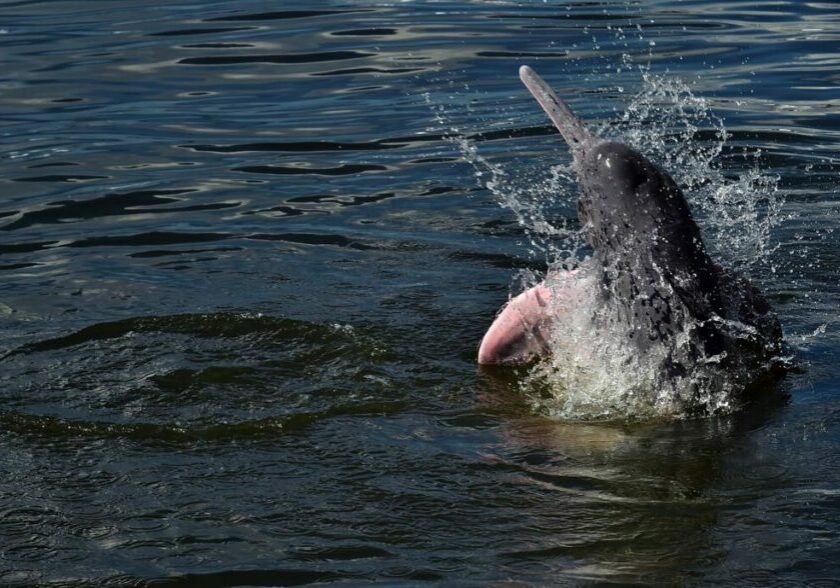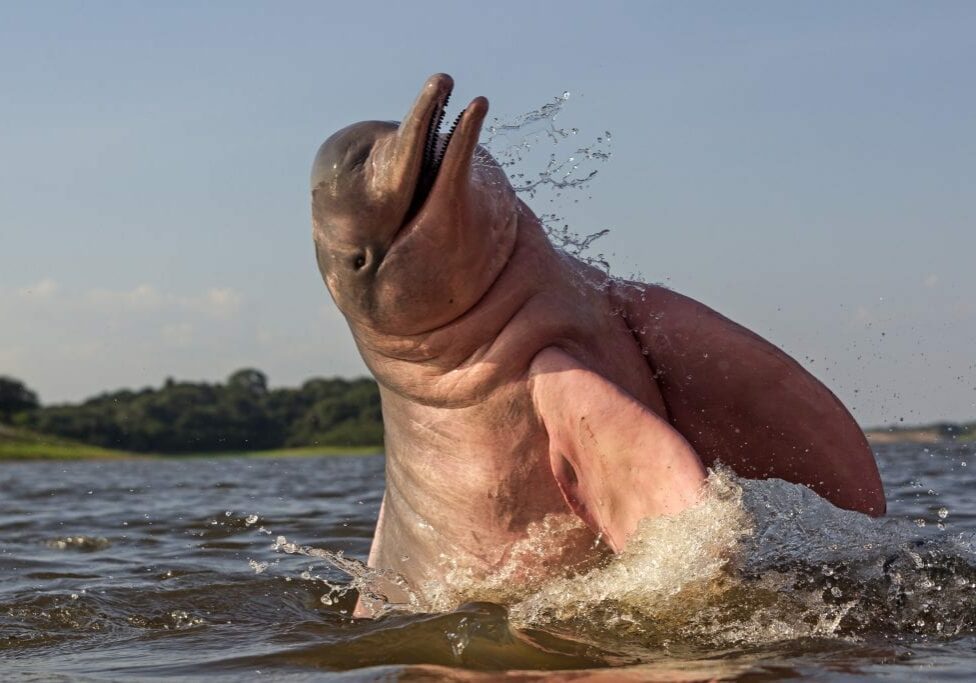As the boat sails up one of the Amazon’s mightiest tributaries, the passengers speak as if they are searching for joy and relief. For hours, they’ve stood in the watchtower, scanning the wide waterway, hoping for a fleeting glimpse that will make their trip worthwhile. And now they spot it!
“It’s always the same. We shout ‘It’s a dolphin! It’s a dolphin!’ We are just so excited. Then we remember that we are scientists and let the science kick back in.”
As Mariana raises the GPS tracker, the other passengers stare far across at shapes breaking the surface, and then they begin to count.
Aquatic mammal biologist Mariana Paschoalini has been here before. In 2014, she was part of the first expedition to survey the river dolphins in these waters. Four years later, a follow-up survey gauged the effects of harmful developments on the river.
In 2022, conservationists are seeking information that will arm them against an impending threat that could bring utter, catastrophic transformation.

© NAY JINKNSS / WWF-BRAZIL
Since before time was measured, the fast-flowing Tapajós river ran its quick course some 2,000km from source to the Amazon itself, passing through habitats from rainforest to Cerrado savannah. Its wild richness could be counted in dolphins.
A now-unimaginable number of pink and tucuxi dolphins were the proof of a healthy, bountiful river full of fish, that also provided for giant otters and lugubrious, seal-like manatees. There was enough fish to be shared between the wildlife and local communities, who depended on the river not just for its harvest, but also for seasonal floods that fertilised their fields with silt. And a supply of fresh, clean water was essential to their daily lives.
All that changed with the discovery of gold, as well as the recent rise in illegal mining. In the decade from 2010 to 2020, mining in indigenous lands in Brazil has increased by 495% (even in conservation areas it’s risen by over 300%).
To extract the gold, the illegal miners still use mercury (a banned element) which leaches out into the river. Contaminants in the water work their way up the food chain, so that dolphins and people accumulate mercury in their bodies, weakening their immune systems and damaging their brains.
At the same time, the world’s insatiable appetite for meat has seen an unprecedented exploitation of Amazonian land, with great swathes of rainforest cut down and replaced with cattle ranches and extensive areas of soy beans and other grains.
The bare, exposed soil washes away, muddying and darkening the river, reducing photosynthesis, blotting out life. Overfishing takes its toll too, as new markets in the region are supplied on an unsustainable basis.

© ADRIANO GAMBARINI / WWF-BRAZIL
When researchers last counted dolphins in 2019, in a project run by the Mamirauá Institute and backed by WWF-Brazil, they saw the results. They were retracing a survey from five years before, which had estimated there were 1,814 pink dolphins and 3,371 tucuxis.
The second expedition showed an alarmingly depleted river, with a reduction of 13% in pink dolphins and 53% among the tucuxis.
If all this were not enough cause for concern, an extra threat is drawing closer, lifting itself off a draughtsman’s page towards concrete reality. So, in partnership with Reckitt and the Mamirauá Institute, we embarked on a third data-gathering journey up the Tapajós in the spring of 2022.
Taming the river wild
The Tapajós Hydroelectric Complex has looked hungrily at the fast-flowing power of the Tapajós and sees a way to harness it for profit. It envisages the construction of seven dams along the course of the river and one of its tributaries to produce green, clean energy.
The evidence from two other dammed – and thus damned – rivers shows that such energy production is neither green nor clean.
Fish and dolphins swim. Rivers flow. The dam-maker fails to respect basic biology and the natural movement of water. When a barrier goes up, fish can no longer move along a river seasonally between their feeding and spawning grounds, and so species dwindle and die out.
The risk of starvation is not the only one the dolphins then face. Only recently we’ve come to understand just how much they roam through the entire length of a river, following the fish and meeting other dolphins to breed.
Breaking up a river into effectively discrete sections – as has happened on other Amazon waterways – prevents dolphins mingling and playing the genetic lottery. Isolated populations of dolphins have – quite literally – a smaller genetic pool to choose from, and so their health suffers as a result.
Meanwhile, the ebb, flow and flood of a river has changed drastically. No longer does the land alongside become inundated and enriched with silty goodness, so the Indigenous peoples and local communities suffer too.
The research team sailed 280km in a sizeable boat from the confluence with the Amazon, then swapped to using a smaller vessel for 280km more through the narrowed channel. And now the number-crunching begins – the survey results are crucial in determining not just population trends for the river’s dolphins, but also in assessing through these beacons of health the state of the river itself. Will anyone listen though?
Mariana is clear about the path the Brazilian government must take to avert a crisis for the Tapajós. “They are still looking at 20th-century infrastructure solutions to a 21st-century problem,” she says.
“They must take into consideration the full impact of these dams on communities, wildlife and the climate, and turn instead to renewable energy that is LowCx3: low carbon, low cost and low conflict with communities and rivers.
“We know there are cheaper, more benign energy alternatives to dams, such as solar and wind power. Our survey will add weight to the argument for using them, instead of dams, to protect both dolphins and people.”
More to explore

Gallery: Keeping watch for river dolphins
In the heart of the Amazon, the race is on to save rare river dolphins’ habitat. Explore this remarkable landscape and see behind the scenes of our monitoring mission

